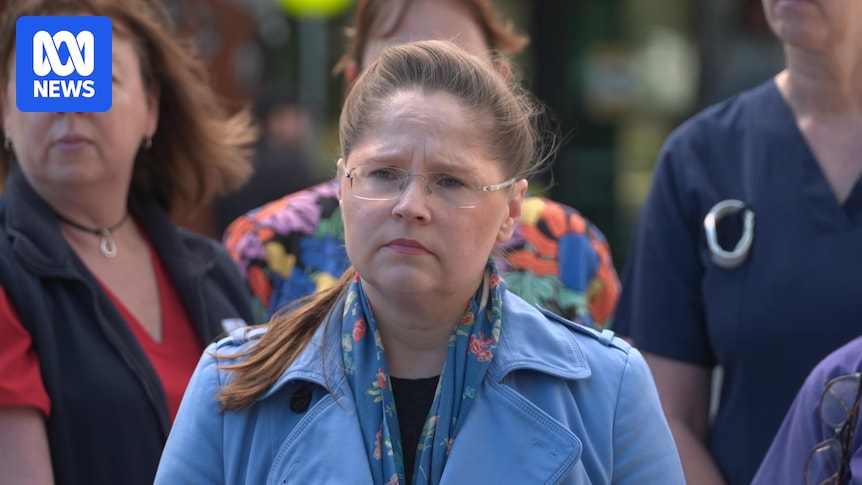Standing outside the Royal Adelaide Hospital emergency department, nurses’ union secretary Elizabeth Dabars did not mince her words.
Three-and-a-half years after Labor was elected on a promise to fix the ramping crisis, one of the state’s key health unions had a message for the South Australian government.
“We are sick and tired of being placated and told that people are working on things,” Ms Dabars said, flanked by a group of members in scrubs.
The union last week went public with concerns over what it calls “internal ramping” — the practice of caring for patients in makeshift areas because no bed is available.
Asked about what had prompted her to speak out about the issue, Ms Dabars said she had spent months trying to work with the government behind closed doors — to no avail.
“We have tried every single avenue humanly open to us to resolve this concern,” she said.
Health Minister Chris Picton fired back, responding “we don’t accept that terminology from the trade union” — while SA Health claimed it was standard practice to care for patients in alternative spaces while they wait for a bed.
The nurses union has raised concerns over what it calls “internal ramping” in hospitals. (ABC News)
Unions find their voice
The nurses are not the only health workers to have aired their concerns publicly in recent weeks.
The unions representing doctors and paramedics have also criticised the government over its handling of issues including ramping, hospital overcrowding and safety.
Ambulance Employees Association (AEA) secretary Paul Ekkelboom last week raised issues of ramping and resourcing in the wake of the death of a man involved in a car crash at Sellicks Hill.
SA Salaried Medical Officers’ Association (SASMOA) chief industrial officer, Bernadette Mulholland, has highlighted safety concerns over working conditions inside hospitals.
Bernadette Mulholland is among the health union representatives who have spoken up about challenges in the system. (ABC News: Shari Hams)
In most cases, a union boss calling out the government is hardly remarkable.
Yet, for much of Labor’s term, health unions faced criticism for keeping too low a profile as ramping hours climbed and the system struggled to cope under enormous strain.
The relative silence was most stark in the case of the AEA, which had played a key role in helping to turf out the previous Liberal government and get Labor into office.
The union helped the then-opposition to humanise the ramping crisis — raising the cases of victims and speaking out about the toll ramping takes on paramedics.
“Ash the Ambo” became the face of the campaign, issuing a powerful warning to “vote Labor like your life depends on it”.
Following the election, the union faced accusations it was failing to hold Labor to the same standard it had the Liberals.
Even as ramping continued to reach eye-watering levels, former secretary Leah Watkins showed a more sympathetic approach to the new government — insisting in interviews it would take time for Labor’s funding boost to alleviate pressure on the system.
Mr Ekkelboom was installed last year as union secretary, thoroughly defeating Ms Watkins after promising to re-establish the AEA’s “political independence” and take a “stronger stance” on ramping.
Paul Ekkelboom replaced former AEA secretary Leah Watkins last year. (ABC News)
Unions in pay talks
The increasing union loudness comes at a time where doctors, nurses and paramedics are all in the midst of pay negotiations, some of which are threatening to turn hostile.
The Australian Nursing and Midwifery Federation said discussions with the government are continuing, while the doctors have already held a stop-work meeting and are planning a strike later this month.
SASMOA wants 10 per cent annual pay increases over the next three years — a demand the government has called untenable.
SA doctors reject government’s pay offer
Bosses have been quick to shut down any link between their recent criticism and the ongoing pay talks.
“Let me be very clear. This is nothing to do with that,” Ms Dabars said on Wednesday.
Mr Ekkelboom said it would be disrespectful to make any comment on his union’s wage negotiations while he was speaking out about the death of a patient.
But public commentary is one of the most powerful tools at the unions’ disposal — and one some are using now more than at any other point in this term of government.
It’s been a quieter couple of weeks for the Health Services Union, which earlier this month reached a deal with the government on their new enterprise agreement.
Labor looks to 2026
Eight months out from the next state election, Labor is widely considered by politicians and pundits to be overwhelming favourites to win another term in office.
With a popular premier and an opposition struggling to land punches, there seem to be only a small handful of issues with the potential to inflict real damage on Labor between now and March.
Labor will be looking to 2026, but a promise to fix the ramping crisis was a key part of its 2022 win. (ABC News)
Whether the difficulty the government has faced to deliver on its promise to fix the ramping crisis is one of those potential banana skins remains to be seen.
Public concern around the state of the health system is not at the same level it was in 2022, when Labor was swept to power on the back of its ramping pledge.
But the state’s health unions hold the power to change that — and, whatever their motivation, they’re looking ready to use it.

